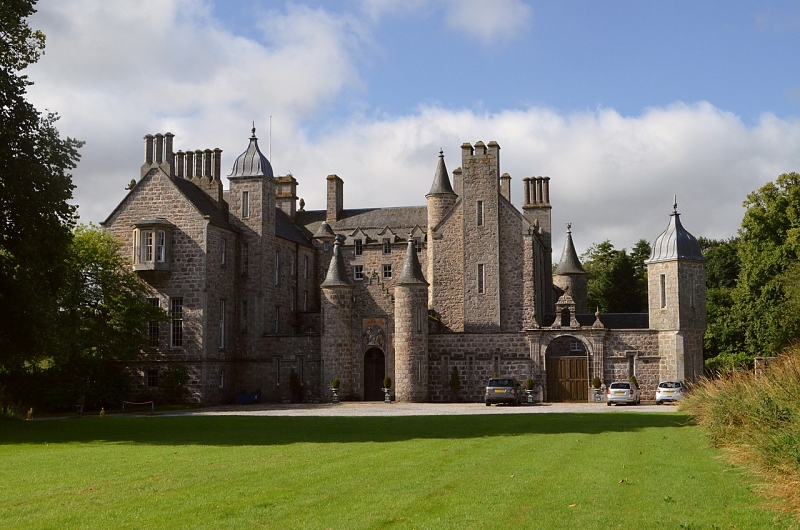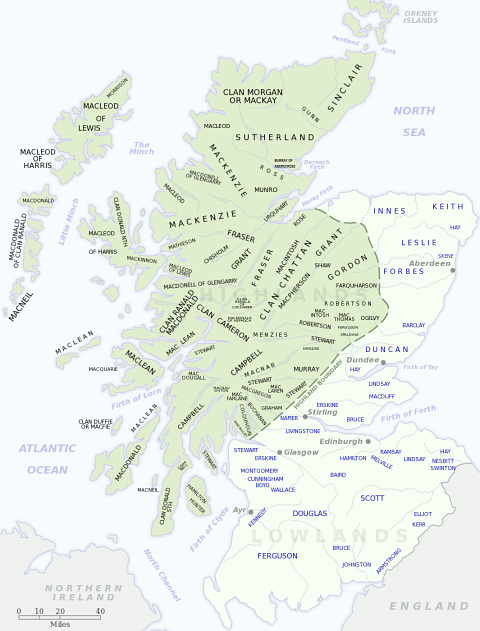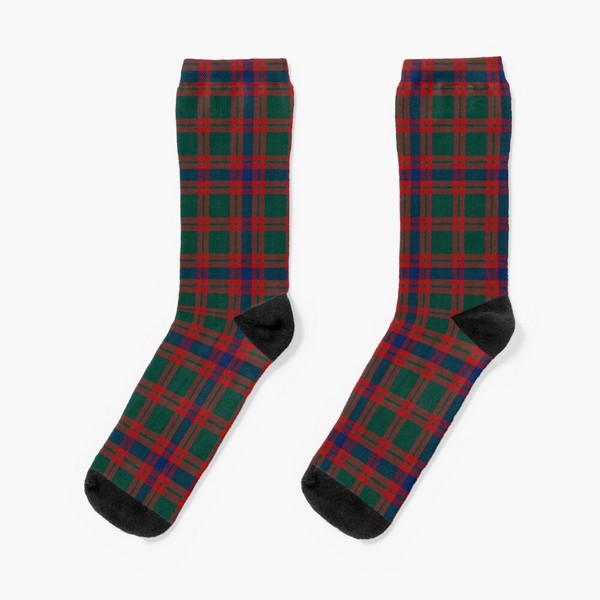
Motto: Virtutis regia merces (A palace the reward of bravery)
Historic Seat: Skene Castle
District: Aberdeenshire
Associated Surnames: Cariston, Dyce, Hallyard
Associated Tartans:
Early Skene Genealogy and History:
(Excerpt from "The Scottish Clans and Their Tartans", James Grant, 1906)
In Aberdeenshire the ancient family of Skene always held the rank of free barons, and took their name from the castle of Skene, in the Earldom of Mar, which was in their possession from the thirteenth century till 1827, when, by the death of the last Skene of that Ilk, the estates passed to his nephew, the Earl of Fife, whose mother was Mary, daughter of George Skene of Skene.
Tradition asserts that the Skenes are descended from the Robertsons of Struan, and that the first of them was so called from having killed an enormous wolf that endangered the life of Malcolm III in the Royal Forest of Stocket with his Skene (or dagger) only. Hence the family and clan arms are gules, three dirks or Skenes supported by three wolves' heads; crest, an arm holding a garland; supporters, two Highlandmen; motto, Virtatis regia merces.
In 1318 King Robert I by charter granted to his beloved and faithful Robert Skene, the lands and loch of Skene (Nisbet's Heraldry).
In 1488, 23rd January a plea is moved between "Alexander Skeyn of that Ilke and Thomas, Lord Erskine." (Acta. Dom. Auditorum).
In 1513 Alexander Skene of that Ilk fell at Flodden.1
A branch of the old family of Skene, designed as of Curriehill, in the Parish of Colinton, were said to be in the some way connected with the Royal family. John Skene of Curriehill came prominently forward as an advocate in the reign of James VI.
In 1594 he was appointed Lord Clerk Register, an office which he seems to have shared with his son James in 1598. Three years before that, he was one of the Eight Lords Commissioners appointed to look after the King's Exchequer, "properties and casualties." He is best known in Scottish legal literature by his treatise "De Verborum Significatione" and his folio edition of the "Regiam Majestatem," which was printed at Edinburgh in 1609, and is a collection, as its title-page bears, of "The auld lawes and constitutions of Scotland, faithfullie collected furth of the Reigster; and other auld authentic Bukes, from the Dayes of King Malcolme the Second, vuntill the time of King James the First."
His son, Sir James Skene of Curriehill, succeeded the Earl of Melrose as President of the Court of Session in 1626. At what time he was made a Baronet is unknown.
Alexander Skene of that Ilk appears in 1633 in the "Book of the Annualrentaris" for Aberdeenshire, together with Alexander Skene of Drumbreck, Gilbert Skene of Dyce, and James Skene of Ramoir.
In 1641 Andrew Skene of Auchtertoole was dubbed Knight at Holyrood by Charles I.
At Auchtertoole an old house called Camilla is referred to in the "First Statistical Account" in 1793 thus: "Its ancient name was Halyards when it belonged to the Skenes; and it is said to have been the rendezvous of the Fife Lairds at the insurrection in the year 1715."
In November 1680 Fountainhall records that a man named James Skene was sentenced to be hanged "for disouning the King."
A brother of Skene of thath Ilk, George Skene of Auchterairne, in 1687 married Mary, daughter of Sir Robert Montgomerie, the third Bart.,2 of Skelmorlie.
(End excerpt)
Next page: Clan Sutherland
Footnotes:
1 The Battle of Flodden (1513): The Battle of Flodden Field was fought on 9 September 1513, in Northumberland England between an army of Scots under King James IV and an English army commanded by the Earl of Surrey. Read more about the Battle of Flodden at Wikipedia.
2 Bart.: Baronet

Distribution of Scottish clans and families
View larger map at Wikimedia Commons

Browse the Clan Skene Tartan Collection with fabric, home decor, accessories, electronics cases, and more.

Browse the Aberdeen District Tartan Collection with crafting, clothing, home decor, accessories, electronics cases, and more.